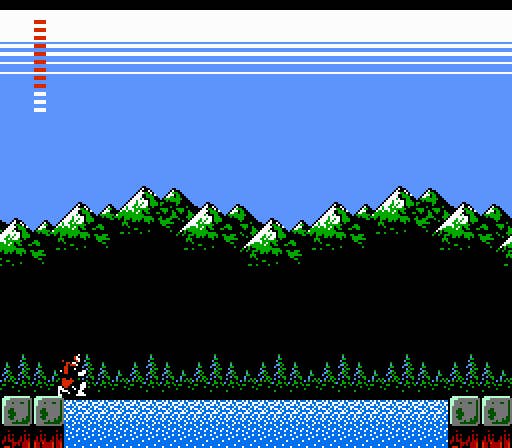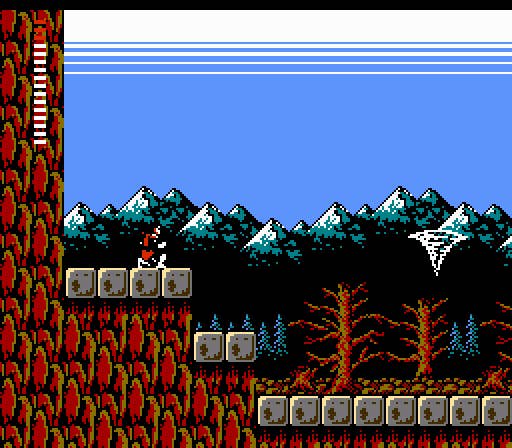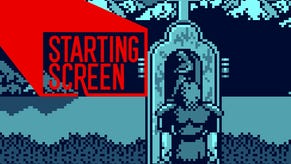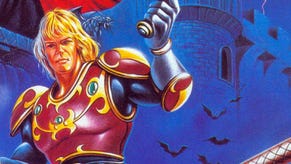Virtual Spotlight: Castlevania II Simon's Quest
Does Simon Belmont's second NES adventure hold up after all these years, or should it be buried with the graveyard duck?
This article first appeared on USgamer, a partner publication of VG247. Some content, such as this article, has been migrated to VG247 for posterity after USgamer's closure - but it has not been edited or further vetted by the VG247 team.
About a year ago, I spent a couple of weeks trying to decide whether or not Castlevania II: Simon's Quest is a well-designed game. After all that time and about 10,000 words dedicated to the subject, I still can't decide.
I guess that's what you call "nuanced" design. It's both clever and lousy by turns: Ambitious for its time, but also so unfriendly as to feel deeply dated these days. The secret to enjoying Simon's Quest is to play with a guide by your side -- not a comprehensive walkthrough, but a looser kind of guide that explains some of the more opaque mechanics. And, for the love of god, that tells you which villagers to ignore. There has never been a bigger collection of total liars in a video game than in Simon's Quest. No, not even in EVE Online.
Such is the way of pioneering art, I suppose. Simon's Quest pulled together a good many concepts that had been floating around in video games for several years, grounding the nebulously grand aspirations of early proto-platformers like Pitfall, Jet Set Willy, Spelunker, and many others by affixing them to the solidly realized mechanics of Castlevania. Early exploratory platformers tended to degenerate into exercises in frustration thanks not only to the abstraction and opacity of their goals, but also because of their rough controls and physics.
Simon's Quest, however, benefitted from the maturation of the medium. Castlevania was forged in the wake of seminal works like Super Mario Bros. and Ghosts 'N Goblins, both of which proved once and for all that action platformers could be fun, but only when built around a consistent interface. Not every hero had to jump like Mario, at once benefiting from and bending the laws of physics, but at the very least they needed to move like brave Arthur: Reliably, predictably, with capabilities and limitations defined from the outset and carried through to the end. Responsive controls didn't hurt.

Castlevania came in at the Ghosts 'N Goblins end of the spectrum, with a protagonist practically tethered to the earth... but thoughtfully so. Simon Belmon's limited skill set meshed perfectly with the world around him, absolutely removing the guesswork from play. Once you got a feel for the rhythms of Simon's jumps and attacks, Castlevania proved to be a wholly manageable adventure despite its brutal reputation -- and not surprisingly, the game's two most notorious sticking points coincided with the randomized attacks of two of the later bosses.
Simon's Quest retained the mechanical consistency of its predecessor, but rather than assembling a linear six-stage action game around those rules it instead plopped the hero into a non-linear, free-roaming, interconnected world. Players were left to their own devices to determine their goals, where to achieve those objectives, and how to go about these tasks. The action expanded far beyond the halls of Dracula's castle, instead ranging into the cursed lands surrounding the vampire's lair. Towns, forests, graveyards, and lakes provided the scenery, with a handful of cavernous mansions scattered throughout the country both housing the player's goals and reaching back for the familiar visual touchstone of castle-like environs to help connect this adventure to the previous one.

Simon even benefits from a touch of role-playing mechanics. He gains both cash and experience by collecting tokens left behind by defeated foes; cash buys him essential tools and weapons, while experience boosts his health. Shops appear in both towns and far less likely spots in unfriendlier areas. There's a trading chain for a certain key item, valuable tips from strangers, and plenty of flavor text.
What really hurts Simon's Quest is its ambiguity. Mixed amongst all these appealing design elements, the game also includes infuriating factors. Half the townspeople deliberately mislead Simon, giving him useless or downright incorrect advice. Putting several essential items to use requires practically blind luck... and since they unlock crucial paths forward, much of the Simon's Quest experience consists of wandering back and forth in bewilderment, covering all the available ground... which is considerable thanks to the open-ended design of the adventure. The original Castlevania had its share of hidden secrets, but they appeared only within the confines of a set of simple stages with a clear objective. And Castlevania's secrets amounted to minor point bonuses and extra upgrades; the game could easily be completed without them. Not so Simon's Quest.

Another oddity in Simon's Quest: It utterly and completely lacks anything akin to challenge. Well, outside of figuring out how you're supposed to use the Red Crystal. Enemies pose little threat that can't be bested with the application of a simple whip upgrade. Monsters mostly just wander back and forth; the interesting patterns and twitchy threats of the first game's enemies have vanished, replaced by dull, dumb foes. And when Simon dies, he respawns on the spot; the only penalty for death is the loss of the experience points you've collected since your last level-up, and you can easily grind for those in mansions, where time freezes to remove the penalties for dallying.
So where does that leave Simon's Quest? Somewhere in the middle: A clever and complex game diminished by opaque design oversights. But the lands surrounding Castlevania remain interesting to explore, the innovative-for-its-time day/night cycle adds a sophisticated nuance to the quest, and the ever-present element of overall quest time propels you forward. It's broken, but good in spite of itself.
ConclusionI have tremendously fond memories of the game (thanks, Nintendo Power, for the essential spoilers), but even isolated from that nostalgia Simon's Quest largely works. Just use a guide, OK? There's no shame in it.
















